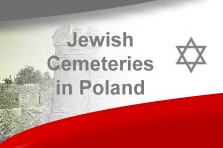In co-operation of 2020 with cmentarze-zydowskie.pl Elbląg (Elbing) was one of the oldest Jewish communities in eastern Prussia. The first Jews settled in the town in 1783. It is known that in 1812 there were 33 Jewish families living in Elbląg (Elbing) and in 1880 there were 549 followers of Judaism in the town. In 1812 a Jewish cemetery was established and in 1824 a synagogue was erected. In 1844 a councillor of Jewish origin was elected to the Elbląg (Elbing) City Council. It is worth knowing that one of the biggest cigarette factory group in Eastern Germany (and Europe), the Loeser & Wolff cigar factory, was founded in 1874 by a Jew from Elbląg (Elbing). In 1926, the company employed as many as 4,000 workers.
Elbląg (Elbing) was one of the oldest Jewish communities in eastern Prussia. The first Jews settled in the town in 1783. It is known that in 1812 there were 33 Jewish families living in Elbląg (Elbing) and in 1880 there were 549 followers of Judaism in the town. In 1812 a Jewish cemetery was established and in 1824 a synagogue was erected. In 1844 a councillor of Jewish origin was elected to the Elbląg (Elbing) City Council. It is worth knowing that one of the biggest cigarette factory group in Eastern Germany (and Europe), the Loeser & Wolff cigar factory, was founded in 1874 by a Jew from Elbląg (Elbing). In 1926, the company employed as many as 4,000 workers.
Certainly not all Jews from Elbląg (Elbing) were doing well. At the turn of the 19th and 20th century, difficult economic conditions caused many of them to leave the country in search of work and better prospects. Their outflow was compensated for by migration movements of people from smaller towns. In 1905, 445 people of Jewish origin lived in Elbląg (Elbing), until 1925 this number remained almost unchanged (434).
When the Nazis took power, the Jewish community of Elbląg (Elbing) consisted of 367 people. The repressions resulted in a rapid, gradual decrease in the number of local Jews: to 207 in 1936 and to 53 in May 1939. Supposedly, it was still in October 1942 – thanks to mixed marriages – seven people of Jewish origin stayed in the town. Unfortunately, we do not have precise knowledge about the fate of Elbląg (Elbing) Jews during the Shoah.
The Jewish cemetery in Elbląg (Elbing) is located at the junction of Brzeska and Browarna Streets. Today, its existence is reminded by a small monument erected in 2001, on which an inscription with the content is engraved: “In memory of the Jews of Elbląg. Former Jewish cemetery 1812-1945”. One of the users of Forum Marienburg describes the post-war fate of this necropolis in the following way: “The cemetery – like most Jewish cemeteries – survived the war in a partially destroyed condition, but with matzevot (tomb stones). In 1965-70, a HYDROSTER building was built on the eastern side of the cemetery – a building that still exists today as a shop with parts for boats and engines. The square in front of the shop received a concrete floor. Matzevot were used to harden the area. Around 1990, the concrete began to fall off and the antique stones appeared. Cleaning work was carried out and the tombstones were removed.
Translation of Cmentarze-Zydowski >>
In co-operation of 2020 with cmentarze-zydowskie.pl

